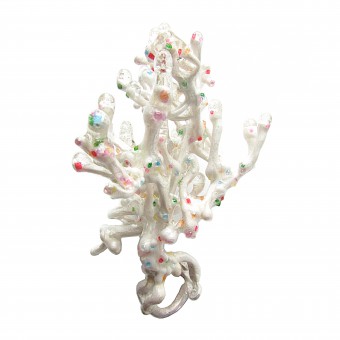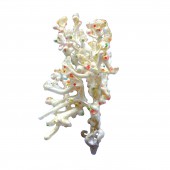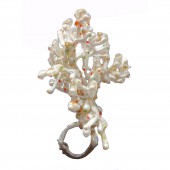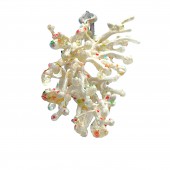DESIGN NAME:
Rainbow
PRIMARY FUNCTION:
Ring
INSPIRATION:
This piece was the first attempt for the artist to use the casting technique. This technique allows people to produce specific shapes from molds, which can be artificial designs or found objects in nature. This artist had not chosen casting for her projects before because her primary focus had been how to fabricate metal by hand, not with machinery or mold. One day, she wondered what casting could do and what by-hand fabrication could not achieve. She made a mold whose shape would be very difficult to form with hand.
UNIQUE PROPERTIES / PROJECT DESCRIPTION:
This ring evokes different memories or images in the minds of viewers through its organic shape. For instance, some viewers may consider this ring an abstract form while some can relate it to something they know, like marine creature. This shape was created by pouring metal into a mold, the process and technique which the artist did not usually use. There is a contrast between the white metal surface and rainbow sugar crystals in the layer of plastic.
OPERATION / FLOW / INTERACTION:
The whole piece started from carving a candle-wax-like substance that jewelers commonly use to make a design. Then branch-like elements were added with carving tools and heat. The artist tried a heat-treatment on the surface to reveal its white color, after observing the solid form which reminded her of dead bleached coral at some degree. By carefully checking its color change, she decided to use colorful grains of sugar. These grains were half transparent, echoing the clear layer of resin.
PROJECT DURATION AND LOCATION:
This ring was formed through casting, which usually took several days to process. Resin layers with sugar crystals were applied multiple times, and each layer needed more than a day to dry. The whole assemblage was completed in winter 2015.
|
PRODUCTION / REALIZATION TECHNOLOGY:
This piece was shaped through casting before depletion gilding was done. Heated silver was poured into a mold, whose shape was copied from a hand-carved jewelers wax(casting). After a solid silver form was made, its surface was enriched by heat and became white(depletion gilding). On its white surface, resin coats were added with sugar crystals.
SPECIFICATIONS / TECHNICAL PROPERTIES:
This ring is 70mm wide at the widest part, 90mm long from the ring band to the top, and 50mm high.
TAGS:
Resin, Sugar, Silver, Ring, Casting
RESEARCH ABSTRACT:
Because the casting technique was new to the artist, she asked how other people cast, and recorded how long the equipments were prepared in kilns and how each operation had to be done. Her design contained fine details which could be easily lost in casting, so more wax was used to thicken these weak spots. Even though all procedures were done with right equipments, casting did not always bring good results. The artist started to understand how this traditional technique was adopted in ancient cultures and how modern machines made this process safer and more successful.
CHALLENGE:
Finding right materials could be a long journey to artists. Here, the plastic coat over the ring was resin, commonly purchased in craft stores. Some products had a low odor and low possibility of yellowing while some did not. The artist was content with how the ring looked at completion, but later realized that the resin she used could be influenced by environmental factors. Even though it was transparent and clean at first, resin started to color possibly due to time(age) and temperature. This long-term experience taught her to record how commercial materials would change over time.
ADDED DATE:
2019-02-01 01:34:40
TEAM MEMBERS (1) :
IMAGE CREDITS:
Ayuko Sakurai, 2018.
PATENTS/COPYRIGHTS:
Copyrights belong to Ayuko Sakurai, 2015.
|










